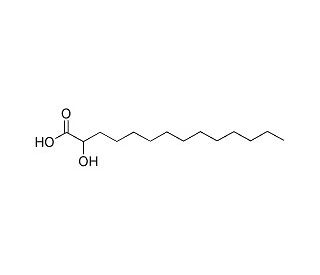

Molecular structure of 2-Hydroxymyristic acid, CAS Number: 2507-55-3
2-Hydroxymyristic acid (CAS 2507-55-3)
See product citations (6)
Application:
2-Hydroxymyristic acid is a protein myristoylation inhibitor
CAS Number:
2507-55-3
Purity:
>97%
Molecular Weight:
244.4
Molecular Formula:
C14H28O3
For Research Use Only. Not Intended for Diagnostic or Therapeutic Use.
* Refer to Certificate of Analysis for lot specific data.
QUICK LINKS
Ordering Information
Product Citations
Description
Technical Information
Safety Information
SDS & Certificate of Analysis
2-Hydroxymyristic acid has the capability to distinguish between myristoylation and palmitoylation, and is therefore able to inhibit protein myristoylation in cells. Many proteins require myristoylation to be fully active, and inhibition of myristoylation by 2-Hydroxymyristic acid will suppress full protein activity. Metabolic activation to the CoA thioester may be required for inhibitory potency in cells. 2-Hydroxymyristic acid is also capable of reducing the quantity of p56lck, a protein partly responsible for T cell activation, available for signal transduction at the plasma membrane through its inhibition of protein N-myristoylation.
2-Hydroxymyristic acid (CAS 2507-55-3) References
- Proposal of Sphingomonadaceae fam. nov., consisting of Sphingomonas Yabuuchi et al. 1990, Erythrobacter Shiba and Shimidu 1982, Erythromicrobium Yurkov et al. 1994, Porphyrobacter Fuerst et al. 1993, Zymomonas Kluyver and van Niel 1936, and Sandaracinobacter Yurkov et al. 1997, with the type genus Sphingomonas Yabuuchi et al. 1990. | Kosako, Y., et al. 2000. Microbiol Immunol. 44: 563-75. PMID: 10981829
- Sphingomonas pituitosa sp. nov., an exopolysaccharide-producing bacterium that secretes an unusual type of sphingan. | Denner, EB., et al. 2001. Int J Syst Evol Microbiol. 51: 827-41. PMID: 11411704
- Sphingomonas aquatilis sp. nov., Sphingomonas koreensis sp. nov., and Sphingomonas taejonensis sp. nov., yellow-pigmented bacteria isolated from natural mineral water. | Lee, JS., et al. 2001. Int J Syst Evol Microbiol. 51: 1491-1498. PMID: 11491350
- Degradation of polyvinyl alcohol by Sphingomonas sp. SA3 and its symbiote. | Kim, BC., et al. 2003. J Ind Microbiol Biotechnol. 30: 70-4. PMID: 12545389
- Cellular fatty acid profile distinguishes Burkholderia pseudomallei from avirulent Burkholderia thailandensis. | Inglis, TJ., et al. 2003. J Clin Microbiol. 41: 4812-4. PMID: 14532228
- The G protein connection: molecular basis of membrane association. | Spiegel, AM., et al. 1991. Trends Biochem Sci. 16: 338-41. PMID: 1949155
- Myristoylation of the small envelope protein of porcine reproductive and respiratory syndrome virus is non-essential for virus infectivity but promotes its growth. | Du, Y., et al. 2010. Virus Res. 147: 294-9. PMID: 19951726
- Sphingomonas rubra sp. nov., isolated from bioreactor wastewater. | Huo, YY., et al. 2011. Int J Syst Evol Microbiol. 61: 1028-1032. PMID: 20511462
- Reclassification of a parathione-degrading Flavobacterium sp. ATCC 27551 as Sphingobium fuliginis. | Kawahara, K., et al. 2010. J Gen Appl Microbiol. 56: 249-55. PMID: 20647682
- Sphingomonas cynarae sp. nov., a proteobacterium that produces an unusual type of sphingan. | Talà, A., et al. 2013. Int J Syst Evol Microbiol. 63: 72-79. PMID: 22328613
- Sphingobium limneticum sp. nov. and Sphingobium boeckii sp. nov., two freshwater planktonic members of the family Sphingomonadaceae, and reclassification of Sphingomonas suberifaciens as Sphingobium suberifaciens comb. nov. | Chen, H., et al. 2013. Int J Syst Evol Microbiol. 63: 735-743. PMID: 22561591
- Metabolic activation of 2-substituted derivatives of myristic acid to form potent inhibitors of myristoyl CoA:protein N-myristoyltransferase. | Paige, LA., et al. 1990. Biochemistry. 29: 10566-73. PMID: 2271666
- Inhibition of enterovirus VP4 myristoylation is a potential antiviral strategy for hand, foot and mouth disease. | Tan, YW., et al. 2016. Antiviral Res. 133: 191-5. PMID: 27520386
- Antibacterial activities of the phytochemicals-characterized extracts of Callistemon viminalis, Eucalyptus camaldulensis and Conyza dioscoridis against the growth of some phytopathogenic bacteria. | El-Hefny, M., et al. 2017. Microb Pathog. 113: 348-356. PMID: 29126952
- A metabolomics approach to characterize raw, pasteurized, and ultra-high temperature milk using ultra-performance liquid chromatography-quadrupole time-of-flight mass spectrometry and multivariate data analysis. | Zhang, YD., et al. 2018. J Dairy Sci. 101: 9630-9636. PMID: 30172390
- Presence of 2-hydroxymyristate on endotoxins is associated with death in neonates with Enterobacter cloacae complex septic shock. | Augusto, LA., et al. 2021. iScience. 24: 102916. PMID: 34409274
- Intracellular ellagic acid derived from goat urine DMSO fraction (GUDF) predicted as an inhibitor of c-Raf kinase. | Raj, AK., et al. 2023. Curr Mol Med.. PMID: 36642883
- Treatment of T cells with 2-hydroxymyristic acid inhibits the myristoylation and alters the stability of p56lck. | Nadler, MJ., et al. 1993. Biochemistry. 32: 9250-5. PMID: 8103677
- Inhibition of varicella-zoster virus replication by an inhibitor of protein myristoylation. | Harper, DR., et al. 1993. J Gen Virol. 74 (Pt 6): 1181-4. PMID: 8389801
- Reversible palmitoylation of the protein-tyrosine kinase p56lck. | Paige, LA., et al. 1993. J Biol Chem. 268: 8669-74. PMID: 8473310
Ordering Information
| Product Name | Catalog # | UNIT | Price | Qty | FAVORITES | |
2-Hydroxymyristic acid, 25 mg | sc-202401 | 25 mg | $122.00 |
